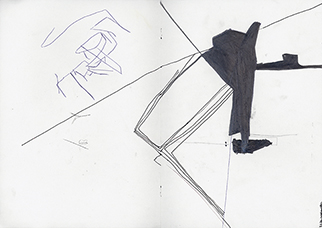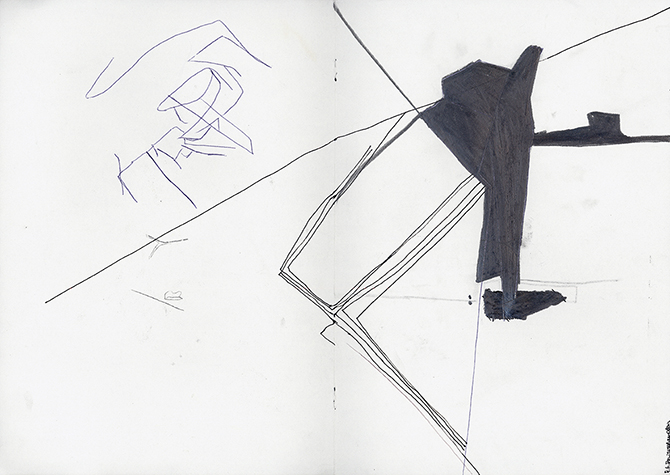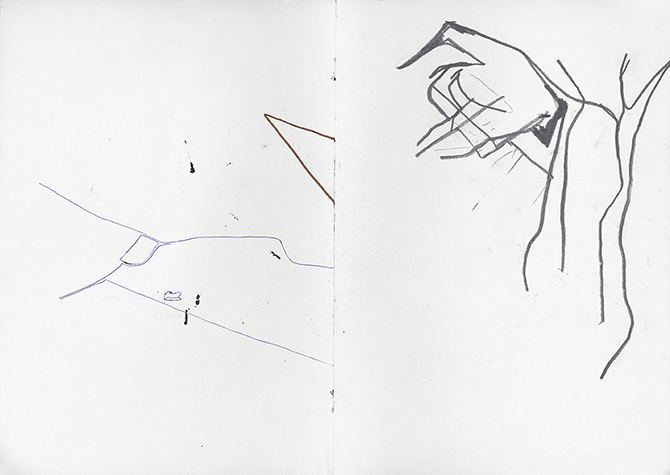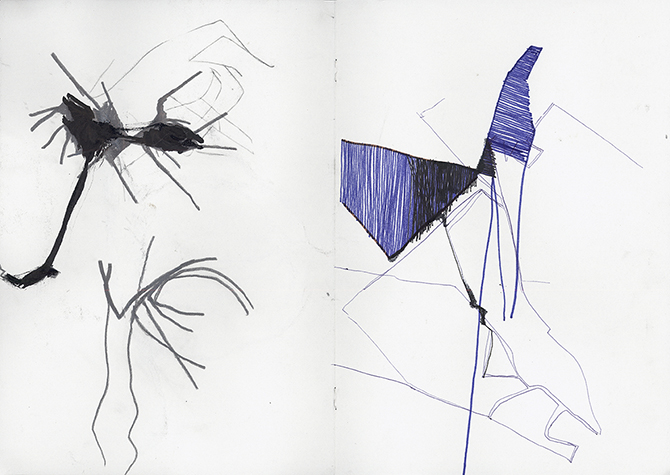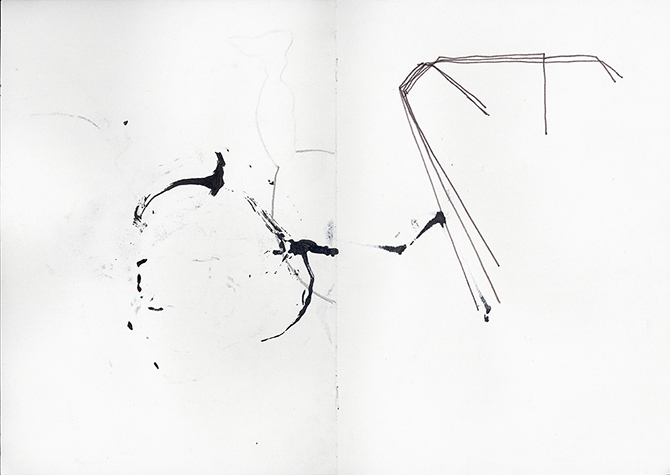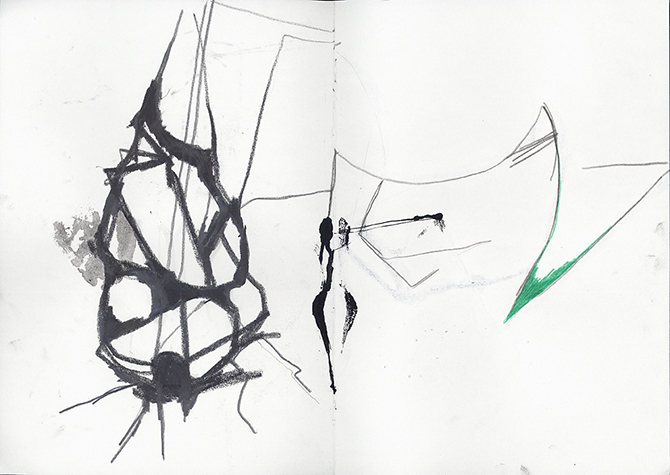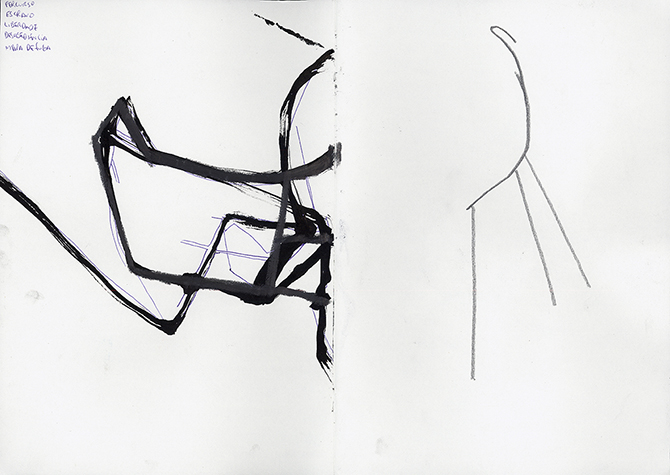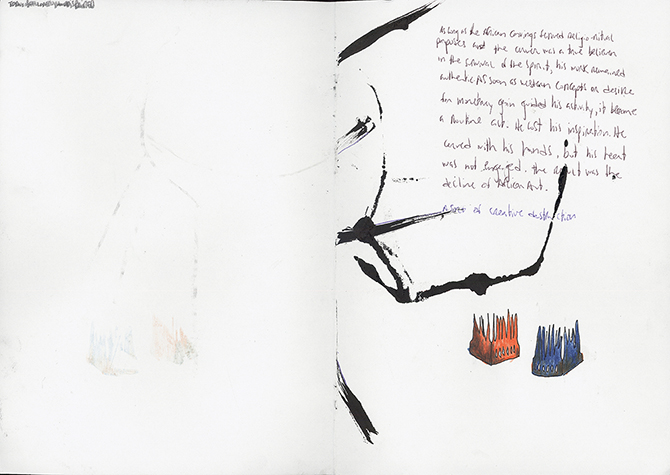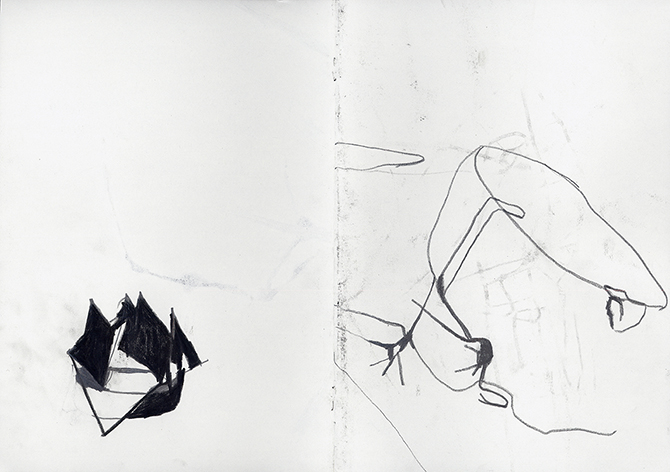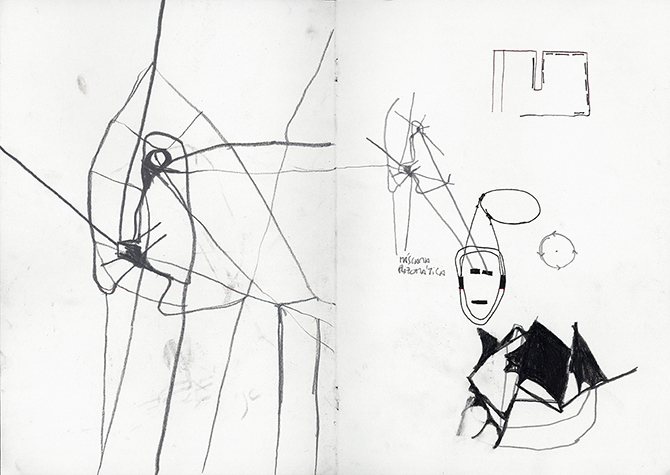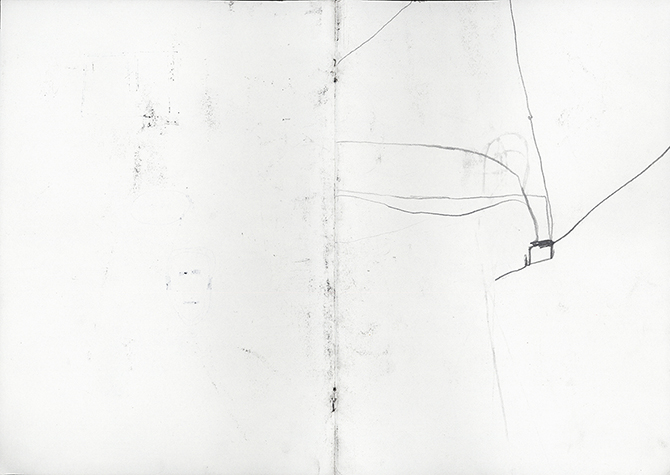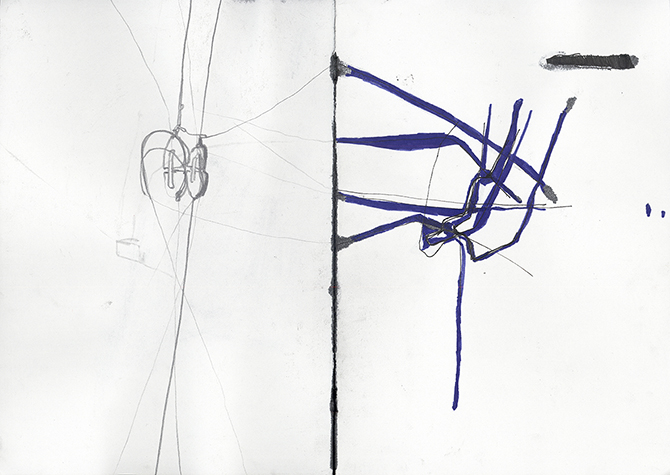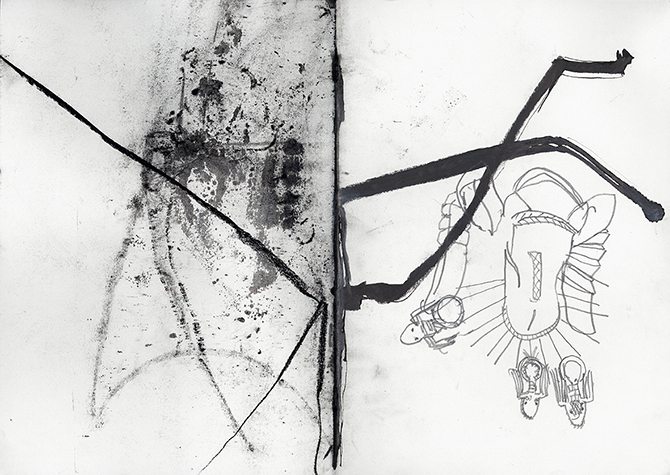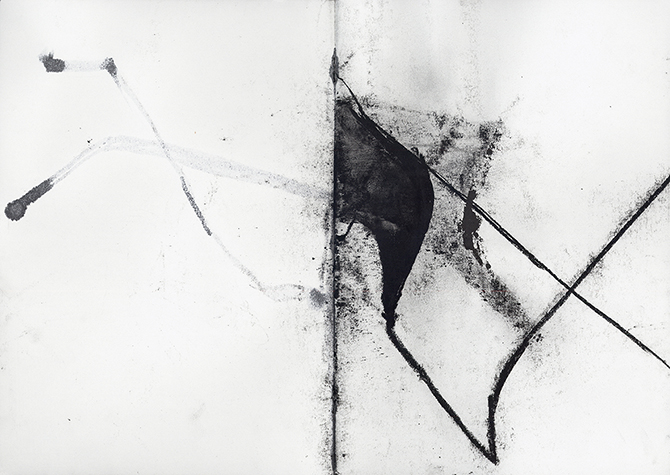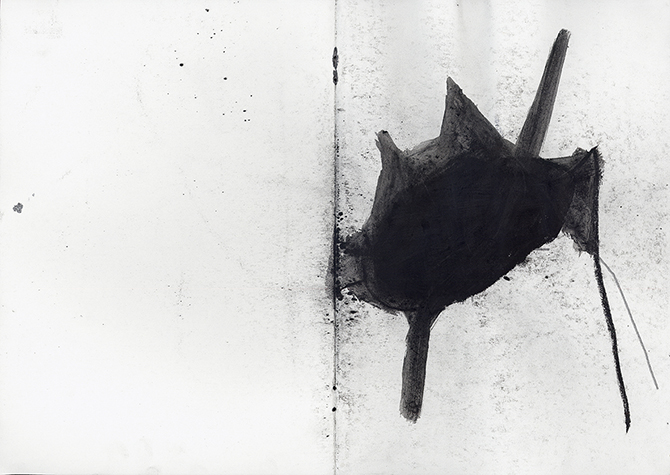
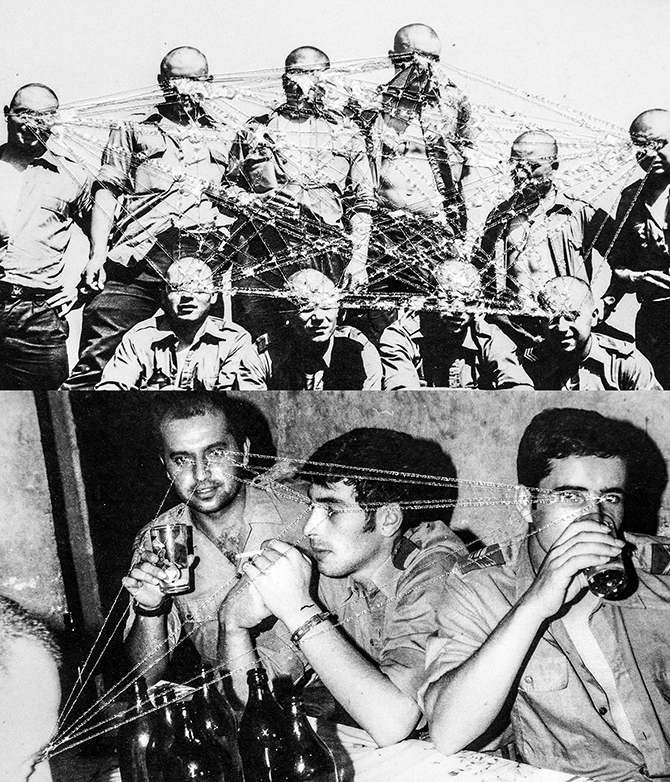

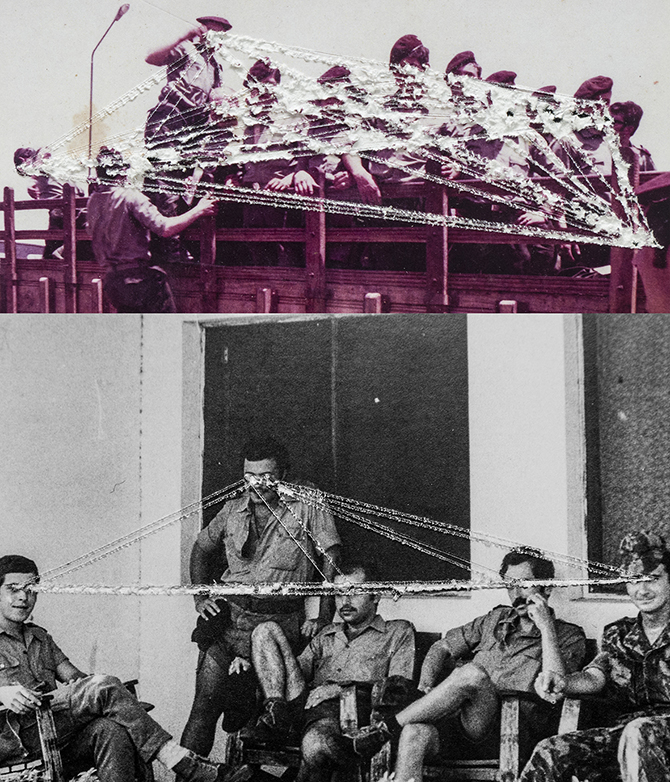
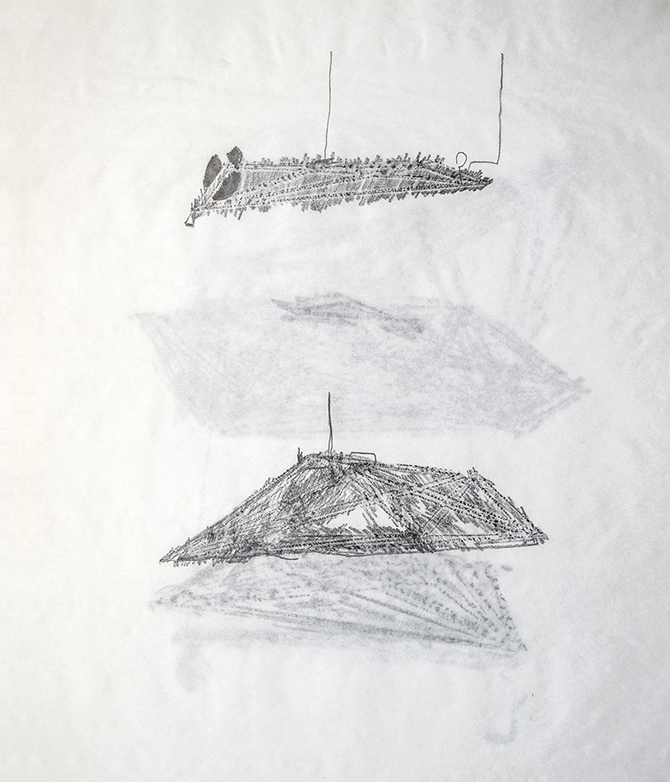
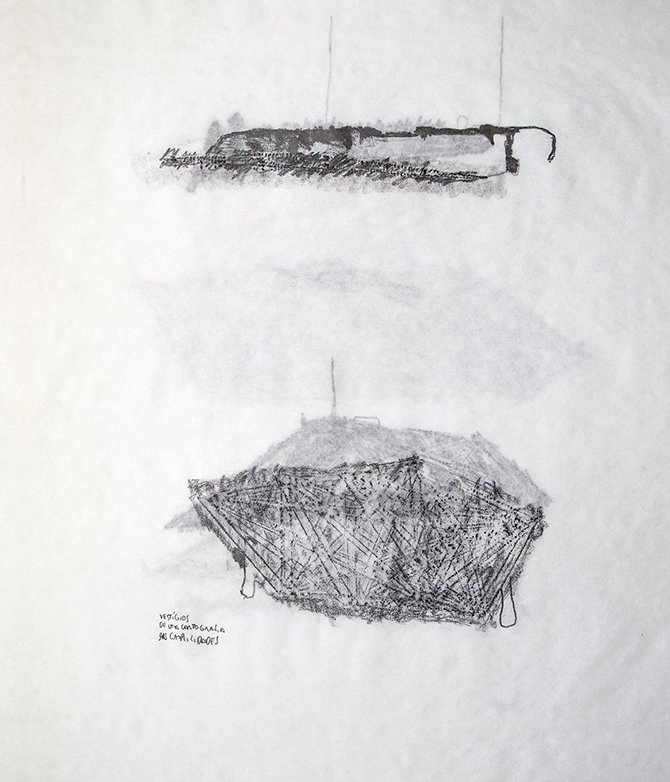


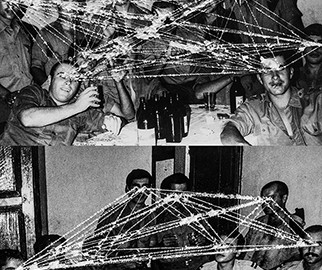









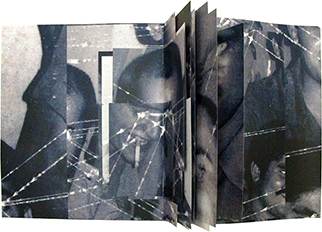
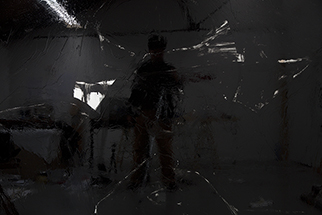
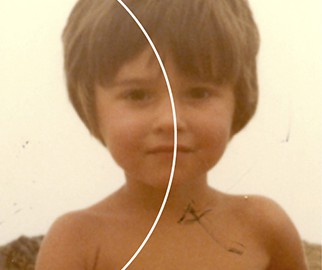
Circular Body
Daniel Barroca, De La Charge, Brussels, February 2015
Written dialogue between Daniel Barroca and Laure de Selys
L: What are these two images and why are they spinning together?
D: Each one is part of a photo album. One is a picture of me as a child at the beach. The other one is from my father’s war album, the album he brought from Guiné-Bissau when he returned from the war in 1974. I found it hidden behind a picture of him with a couple of other Portuguese soldiers. I knew this image of him with the other soldiers in the album very well. But one day I realized there was a suspicious additional thickness behind it that made me open the plastic layer and pull it out. This is how I found the image I’m using here.
L: Can you describe this image?
D: It’s a black and white photograph of a young man beaten to death. He is lying on the floor, the belly uncovered, the t-shirt chaotically pulled up, his face broken by the brutal violence, his left arm randomly still, blood everywhere. I think I was 10 when I saw it for the first time and the explosion of emotions caused by the confrontation with that image was immediately swallowed in silence. I kept silent.
L: So exhibiting these two images today is about battling that silence.
D: I still don’t understand if I decided to keep this image with me or if it decided to stay with me. I guess I’m trying to formulate my relation with it.
L: There’s an animist touch in what you say. As if this photograph through its’ violence had a specific power. That it chose you as much as you chose it.
D: What I mean is that I didn’t choose to see it. I just saw it and that’s it. It’s an irreversible event in my life that conditioned my perspective on what an image is and then on everything that as to do with colonial history in general. The fact is that we stayed together until today.
L: In a way you mean that this image is part of your own personal and political historicity.
D: In other words, it inscribed itself on my body like an invisible tattoo. Like an image impregnated in my flesh, circulating in my veins.
L: It nearly sounds like it’s part of your own biology, a part of your DNA, a political DNA.
D: Yes, even though you almost never see it whenever you look at or feel about yourself, it is within you and you are under its’ influence since the day of that first gaze. But when you become aware of this, what is it exactly that stays in you – the vision of that death? or something of that dead man himself?
L: I don’t really follow you. Is it possible that the existence of this image is not only a consequence of this man’s death but somehow an inclusive part of his murderer?
D: As an adult I asked again my father about the history of this image. He told me that it was the kind of image that used to circulate among soldiers, some kind of war pornographic imagery that was used to challenge the newcomers. So, in the context of the colonial war, this image was sold to young soldiers as to challenge their own existence as part of a community through the visual circulation of violence. Through the contamination of the gaze since the first moment they arrived.
L: So, you first grew up with the idea in the back of your head that your father may have taken part in the murderer of this man.
D: In the back of my head, yes…
L: Therefore, thinking that the conditions that annihilated him were the same that created you and that you were part of one same chronology of appearances and disappearances.
D: That the victim and the aggressor always coexist in you. That you are both.
L: What is this sound?
D: It’s the spinning of different metallic broken objects around my head. A slinger without the shot.


Under construction…

I want to find a way to bring Alberto Caeiro to life through the geometric shape in the Astrological Chart that Fernando Pessoa drew for him around 1914. I want to find a scientific process to translate this diagram into the feasible conditions of production of a real human being. Through a friend who is involved in the academic scientific world in Portugal I found my way to discuss this subject with a scientist from the university of Porto who spends much of his time researching in the neurology department of that University and who also collaborates with research institutes such as the MIT, Rockefeller University, University of Cambridge, Max Planck Society among others. He preferred to keep his anonymity due to the fact that we had a very brief conversation based on non-verified hypothesis and because ethically speaking this is a very delicate subject to which he doesn’t want to be related in the future.
D: My idea is to use the diagram configured by an astrological chart to create a human being. I want you to tell me if it’s possible and how to do it.
?: Let me see. First of all, why on earth would you do something like that? Second, from the stand of our deontological ethics is totally unacceptable! If one day someone puts something like that in motion I would be part of the first ones to actively oppose it. Meaning that I would go and set the place where someone might be pursuing such a thing on fire. But if you put it as a joke… I love good jokes.
So, where can I start…?
D: From the beginning. The geometric shape… I want to bring Alberto Caeiro “back” to life!
?: Alberto Caeiro. How humble! (Laughs)
Ok. We have a geometric shape, a figure that is the result of a pseudo-scientific calculation, an astrological calculation. But it’s a shape with precise edges that we can measure, analyze, reproduce, turn into a mathematical formula that can be turned into a code, and then an algorithm that can be interpreted by machines that can materialize a human replica using 3D Bio printing technology. This already exists and according to some companies will be very common in 10 or 20 years. They are preparing the market. If this is accurate in 10 or 20 years we can print human organs, and body parts using artificial human tissues made from human stem cells that can have a real function in a human body. We can already produce artificial human skin. You now that don’t you?
D: Yes, I heard about it…
?: It’s already being used.
The material part of your problem is not such a big deal because of the possibilities that already exist and the ones we see becoming real in a near future in terms of materializing human body parts. Eventually we can produce something that looks exactly like a human being as we please. Short, tall, blond, dark, blue eyes, brown eyes, black, white, red or yellow, whatever. If there is a specific body part that is still not possible to produce it will be for sure in the future. Just give time for genetic research and technology to develop and then to companies to see a business opportunity and it will be common. Every hospital will have its own 3D Bio printing team producing organs and body parts. Prosthetics as we know it today will become totally obsolete.
Even the production of the human brain had major breakthroughs recently when a team from an Austrian lab managed to produce a mini human brain! These brains are not as our normal brain. They are a sort of primitive version of it, developed from human stem cells, that give us the perspective that it will be possible to breed brains like ours in petri dishes in the future.
On top of all this we already cracked the human genome, we can manipulate and recreate it and shape a human being by introducing or erasing information into the DNA sequence. Again I think I don’t need to explain you the ethical problem that this represents…
…
Recently Jeremy England, a physicist assistant professor at the MIT, came up with a new theory about the existence of life that might be interesting in connection to the brain breeding I just mentioned.
D: Can you tell me about it?
?: … well, it’s something that is dividing scientists. Many people have great expectations on how it will develop and others dismiss it as sheer speculation. Realistically speaking I have doubts, but for your fictional project here it might be interesting. From the standpoint of physics, there is one essential difference between living things and inanimate clumps of atoms. The first one tends to be much better at capturing energy from their environment and dissipating it as heat. This is what makes a living being a living being, it is a closed self regulated system that processes energy into heat in a way that makes it’s cells self replicate and configure a complex organism. An organism such as a plant or an animal. Maybe we can say that this process of turning energy into heat is a sort of metabolism that regulates the growth of a living organism. What England claims is that if we provide the proper environment to a group of atoms, a proper source of energy within a proper heat bath (in other words a proper atmosphere), it can gradually restructure itself in order to dissipate increasingly more energy, in other words it can optimize its condition to grow, organize itself and become a proper living organism as I just said. In England’s words “You can start with a random clump of atoms, and if you shine light on it for long enough, it should not be so surprising that you get a plant.”.
The Austrian team developed human brain tissue from human stem cells and placed it into a spinning bioreactor that circulates oxygen and nutrients, catalyzing the eventual growth of cerebral organoids. I mean cerebral organisms, cells linked together in order to form a complex organism that in this case is a brain. And after one month, the tissue had organized itself into basic developing brain regions, including the retina and cerebral cortex. What basically I’m saying is that these guys did with a human brain what England is speculating about life in the planet in general. They putted specific cells together, consider them as the atoms that England refers to, in a specific set of conditions to produce a specific organism. I didn’t verify this myself but the sources are credible and therefore we can assume that it will be possible to make a human brain exactly like ours at some point in the future. We have more than enough knowledge to pursue that. It’s yet not possible but we know the way to get there.
I’m putting all these things in a simple way so that you can understand because you don’t have the scientific knowledge to understand the technical terms but obviously there is a lot implicated in this.
D: Can you be more specific? I’m very interested!
Ok, then I just give you some topics for you to look more in depth.
Jeremy England is dealing with the second law of thermodynamics, also known as the law of increasing entropy or the arrow of time. Thermodynamic equilibrium. Closed systems and open systems. A body is a closed system in an irreversible thermodynamic equilibrium. Self-replication as a ‘survival’ strategy of the matter, in other words, the cells in a body replicate themselves to survive, to constitute a whole that gives them higher chances of survival or, even in other words, your body grows to sustain itself in terms of energy processing and to process more. One of the steps forward that England gives is that he considers systems as small as chemical circuits involving a few biomolecules that then replicate themselves in a scale of let’s say… a human body. Do you understand? He puts a complex organism as a large version of a very simple small system and he validates that assumption with a mathematical formula. I’m sure it’s an insane complex formula and I’m not going into that because I have little knowledge of it and I’m not a physicist and we’re just fooling around with these ideas.
In this sense we can even consider that we have two possibilities to produce a human being.
One is the 3D Bioprinting and the brain breeding process of the Austrians. Meaning that we could produce a human body in separate parts that in the end we could assemble. The second option is the one of England’s theory, that if we put the right atoms together and nurture them in the proper conditions we can grow a human almost like a plant. Perhaps with everything that a human body can have, a skeleton, a blood system, muscles, a brain, a fairly ok nervous system, skin, hair, etc… (this is my pure creative speculation to respond to your crazy proposal). (Laughs)
D: I can get from your tone that there is a but…
?: Yes and a big one!
But… the most difficult part is the mind, the consciousness. How can we produce that? The mind is the most difficult thing for scientists to explain. It really is! Because it’s not just a matter of having a brain attached to a nervous system operating a human body. Consciousness is that mysterious force that makes all those neurons and synapses “tielt” and merge into “you”. And that is the unexplainable part. How does it that “you” become “you”? We usually don’t go into where the mind comes from, we just observe its functioning and the way it engenders behavior. But…
D: Another But…? Please go on!
?: … I’m just making a mash of things that might become an interesting idea for your work.
… my colleague Max Tegmark, also from the MIT, is working on the idea that consciousness is a state of matter. I say idea because his approach is totally conceptual. He doesn’t mean that there is a physical part of your brain that is powering your sense of self and your awareness of the world. He’s saying that it arises from a particular set of mathematical conditions that has varying degrees of existence just as certain conditions are required to create varying states of vapor, water and ice. He calls this state of matter the “perceptronium” and uses the term substance when it comes to refer to it. It is a conceptual construction that serves us to understand how does the conscious is formed. Do you see? We are talking about the most general substance that feels subjectively self-aware in a conceptual level. This substance stores and processes information in a way that forms a unified indivisible whole. Because consciousness is impossible to divide, it either exists or not, and it is independent from the outside, its information dynamics is determined from within even when of course influenced by external conditions. Tegmark says that if so and if it is a state of matter than it constitutes itself as a means to an end (as a device that processes the surrounding world) but also as an end in itself (something that works to feed itself) and to constitute itself as an object.
…
Maybe I’m starting to loose it a bit but let’s go on.
D: I think I lost it a while ago but please go on!
?: I will. Now I’m enjoying it! (Laughs)
I bring over the work of my colleague Tegmark because if we end up saying that consciousness is an object then we have a ground to speculate on the possibility of using the geometrical figure of the astrological chart as an object that might serve as a model for creating the consciousness of your poet, Alberto Caeiro. This is also a bit like Ray Kurzweil and his speculation on how to create a mind. In very very simplistic terms he claims that you can create a mind by pattern recognizers. In a way it goes in the same direction as saying that the mind is a mathematical matter. It puts the solution on something that even if very complex and difficult to grasp, is purely logical. If it’s purely logical then we can reduce it to a formula that we can apply and vice-versa, it’s like a spiral in terms of how and why.
D: A spiral? Spirals are always mysticism to me… (Laughs)
?: Maybe all those things about sacred numbers and geometry could add something to this. Maybe in terms of methodology could be interesting.
But going back to England and his life theory. Perhaps we can apply his theory to this “state” of matter of the consciousness and create a singular mind if we stimulate the brain that we might physically produce as I said by nurturing it with the right substance. The right substance is the right mathematical conditions that can shape the ‘perceptorum’ that we’re looking for. I hope you’re following me… I’m playing your game, don’t know if I’m making much sense. (Laughs!)
D: Don’t mind my ignorance, please go on!
?: Let’s make it even more over the top. I just read an article in Quantum magazine that starts like this: “Physicists have discovered a jewel-like geometric object that dramatically simplifies calculations of particle interactions and challenges the notion that space and time are fundamental components of reality.” They call Amplituhedron to that geometric object. It’s basically about gravity, locality and unitarity and it goes really heavily into quantum theory. But what matters is the fact that we’re talking about geometry and about the fact that a geometrical object can engender time and space or dismiss it. And now I’m going to be poetic in my assertion, is that ok? (Laughter)
D: Please!
?: Pessoa is a reference not only for artists and poets, but also for scientists like me. Artists are very important for neuroscience and do you know why? Because, the brain loves the brain. The human brain tends to replicate itself when confronted to creative tasks performed in an external environment. For example, I saw your drawings and for me they are brain structures. You told me you never thought about it and that’s really great news because it proves that your creative process is in a way something similar to what I said about England’s systems. The brain spontaneously works to expand and grow its capacity of processing energy when exposed to favorable conditions. In a movement that goes outwards it engenders forms of interaction that replicate itself, in this case literally as an object. From this point of view, an art practice is an expanded human brain, therefore, something very interesting for neuroscience. It exposes the inner nervous logic of a human brain almost as if we can see it in motion and expanding in front of our eyes.
D: That’s a very interesting perspective on an art practice…! What about Caeiro?
?: Yes, back to Pessoa, Caeiro and the Amplituhedron. I see Pessoa’s heteronymous as entities that somehow produce a fracture in our notions of time and space. They engendered a substance that is freed from time and space. Their existence somehow draws a parallel with the Amplituhedron. Do you get my point? If you apply the idea of particle interaction with no influence of time and space to Caeiro’s existence based on his life geometry (his astrological chart) under the light of the things I’ve told you during this conversation, maybe you can bring him back. Back from another world like the recursion relations that Arkani-Hamed talks about in his research on the Amplituhedron. He says that what we need to understand is what world is that. His study shows us that time and space perception is a matter of perspective. Other researchers are actually saying that the universe is a 2D environment that we perceive as 3D because we encode it like that. Like a codec that unfolds a compacted file. If we shift perspective we can understand many things we could never imagine.
In the end of the day the understanding of what is that shift is what as been shaping science and knowledge since human existence.
It’s a fact that in Physics there are different spacial dimensions, that particles can travel through them and that they can even exist in several of them at the same time. What does it mean to bring someone back? Do you really believe that Caeiro is just a well thought fiction? That he had never been in this world? At the same time that he had never been here, he had always been here. Pragmatically speaking he might already exist. The geometric object we have, made out of those astrological calculations, is just the object that allows us to decode it as we decode the illusory 3D out of the real 2D of the universe and tap into the logic of its existence as a form of reality that we perceive from a certain perspective and that we can eventually turn on and off.
(co-edited by Tracy Rosenthal)


A montage of attractions
These two images come from different worlds, and periods in time and both revolve around two men that did not know each other.
I came across the first photograph at the Museum Jorn in Silkeborg, Denmark. The other is from the private archive of Manecas dos Santos (who was in command of the northern front during the liberation fight) and was shown to me by a friend, Catarina Laranjeiro, who has been engaged in recovering private photographic archives from previous freedom fighters in Guiné Bissau.
The first image is taken by an unknown photographer probably some time in the 1930’s. It shows the Danish avant-garde artist, writer and thinker Asger Jorn (1914-1973) mounting a painted canvas on the outside wall of a country house, probably in the Danish region of Jutland, while being watched by a man and a little girl. In the second photograph (photographer also unknown and taken in the early 1970’s) we see a group of freedom fighters from PAIGC, The African Party for the Independence of Guinea and Cape Verde, somewhere in Guinea-Bissau. While two of those men set a mortar probably to bomb the Portuguese colonial troops, Amilcar Cabral (1924-1973), wearing the sumbia (a knitted cap worn by many men mostly in Guiné-Bissau, Gâmbia and Senegal), inspects the landscape as two others also do. Cabral was a Guinea-Bissauan and Cape Verdean agricultural engineer, writer, and a nationalist thinker and one of Africa’s foremost anti-colonial leaders.
It seemed to me before, in an ineffable way, that the figures of Jorn and Cabral somehow attracted each other. The energy in Cabral’s texts “The weapon of theory” from 1966 http://www.marxists.org/subject/africa/cabral/1966/weapon-theory.htm and “National Liberation and Culture” from 1970 http://www.historyisaweapon.com/defcon1/cabralnlac.html seemed to dialogue with the energy in Jorn’s words, especially those in the publications released with Jorn’s Scandinavian Institute of Comparative Vandalism founded in 1961. The linkage of the images of these two men formalize and formulate that attraction.
The concept that emerges from this attraction is the one of Emancipation. In both images we see people preparing their instruments of emancipation. This emancipation depends on reactivating the links to the layers of ancestry knowledge that modern society disabled, in order to satisfy the need of its productive system. The construction of the future lies on understanding the relation of the present with its ancestry through concrete actions pursued on the field.
Cabral and his men seek to emancipate from the domination of a colonial imperialist system by relinking with the historical process of Guinea (Africa) before the Portuguese (European) domination. Jorn seeks to emancipate from the domination of a dialectical system of thinking that leads to dualistic notions by introducing a trialectic system of thinking that leads to complementarities instead of dualities.
The drawings attached to these images were made under the influence of this attraction with the concept of Emancipation on the horizon with the literal intention of drawing links between apparently diverging energies on a piece of paper.
(edited by Hilde de Bruijn)
Uma montagem por atrações
Daniel Barroca
2013
Montagem de atrações:
Sergei Einsenstein, adaptou ao cinema uma técnica de montagem utilizada no teatro do Proletkult soviético, que se chama, montagem de atrações. A definição desta técnica dramatúrgica, segundo o próprio, é mais ou menos esta: Uma atração é um momento agressivo no teatro, ou seja, qualquer acontecimento que sujeite a audiência a uma influência emocional ou psicológica, verificada através da experiência e matematicamente calculada para produzir choques emocionais específicos no espectador, de acordo com uma ordem dentro do todo. Estes choques fornecem a única possibilidade de compreensão do aspecto ideológico daquilo que está a ser mostrado, até ao culminar da narrativa[1].
É esta a génese da estética do choque, fundamental para o cinema de propaganda soviético[2]. A estética do choque tem como princípio mobilizar, e revolucionar, o espetador através das imagens em movimento do cinema. A recepção da obra cinematográfica é uma experiência colectiva (recepção colectiva simultânea como lhe chamou Benjamin): dentro da audiência, cada indivíduo experiencia uma transformação emocional provocada pelos sucessivos choques, produzidos pela montagem de atrações, que revolve a sua consciência. Esse revolver interior, de ordem ética, induz a um despertar político que, idealmente, leva a uma tomada de ação concreta que é o gesto concertado de todos os indivíduos que sofreram essa transformação em simultâneo. Em suma, existe uma correspondência dialética entre transformação individual e transformação colectiva. A escalada dialética desse revolver colectivo leva à mobilização das forças e dos meios que concretizam a transformação da humanidade. Resumindo, a aplicação da estética do choque é o trampolim para a revolução.
Depois da segunda grande guerra, Edward Bernays[3], tal como Adam Curtis nos mostra no seu documentário The Century of the Self[4], perverteu esta lógica ao utilizar técnicas de montagem e propaganda para manipular o desejo latente no inconsciente das massas como parte das suas estratégia de mercado. Segundo Curtis, Bernays compreendeu como ninguém a articulação entre a imagem e o inconsciente transformando a propaganda política em marketing. Hoje, o marketing modela o nosso desejo desde o minuto em que nascemos. Ele diz-nos como podemos e devemos ser indivíduos; fornece-nos modelos de nós próprios. É assim que o mercado nos mobiliza através das imagens. Elas dizem-nos o que queremos e como ser. E o que queremos, é consumir os bens que nos fazem ser o Eu que desejamos ser. Foi assim que segundo Curtis, certamente inspirado por Zygmunt Bauman[5], fomos transformados em indivíduos sedentos de mais e mais individualidade. A ideologia do colectivo foi desmantelada, porque cada um deixou de se compreender como uma parte ativa de um todo e passou a compreender-se como uma finalidade. Isto é, tudo funciona para a finalidade de eu poder ser, sempre e apenas, Eu. A minha ideologia, no alinhamento com o marketing, é construir um mundo em que tudo satisfaça a minha necessidade de ser esse Eu.
Se as vias de concretização dessa finalidade são de ordem consumista, se é comprando que eu acedo às condições materiais que permitem configurar a minha vida de modo a poder satisfazer a minha necessidade material de ser cada vez mais Eu, isso significa que este Eu é também um produto do mercado. Eu é uma mercadoria que eu optimizo e coloco no mercado de trabalho. Esse Eu, que está profundamente incrustado em mim, pensa, vê-se e vive como um produto. Eu creio que Ele (Eu), aqui e agora, enquanto reflito sobre este assunto, não sou eu – mas, em algumas circunstâncias da minha vida quotidiana talvez até seja porque, de facto eu não consigo ver onde é que Ele começa e acaba; as suas metástases nos gestos que povoam os meus dias são invisíveis. O que me parece é que muitas vezes, espontânea e estranhamente, os nossos desejos de facto parecem coincidir.
Como é que posso emancipar-me do desejo de um Eu que me coloniza, controla e é insaciável?
Ver:
O que Einsenstein e Benjamin nos dizem em relação à potência política do cinema, é parecido com o que Schiller já nos havia dito nas suas Cartas para a educação estética do homem em relação ao Belo[6]. O despertar da consciência que leva à transformação humana é de ordem estética: “resolver aquele problema político… passa pelo problema estético, uma vez que é pela beleza que se caminha para a liberdade.” [7]. Aquilo que me faz perceber que eu posso mudar o mundo é algo que eu vejo. Algo que vejo à minha frente ou dentro da minha cabeça. Que vejo para além do alcance do meu olhar. Que vejo dentro de um poema ou a partir de um discurso. Que ‘vejo’ através dos meus sentidos, na minha imaginação ou num sonho. Que vejo projetado na abstração do meu horizonte afetivo. Ter uma visão, ver o futuro, um futuro que inclui um caminho que é o meu e que eu posso transformar. Para adquirir a convicção de que o posso fazer, eu preciso de ver e de compreender esse poder transformador em relação a mim próprio. Preciso de o ver dentro da mensurabilidade da minha escala, ou seja, na medida do meu alcance enquanto ser humano. No que posso abraçar. Na minha prática. É isso que é o belo em Schiller. É o poder humano de produzir o objecto cuja ordem interna reformula e eventualmente transforma a sua ordem externa, isto é, o mundo que o rodeia.
Numa conferência no VanAbbeMuseum em Eindhoven, Jacques Ranciére, ao ser confrontado com uma questão que implicava formular o que é a arte, dizia: “para mim uma obra de arte é uma coisa com a qual eu não sei o que fazer. É esse o seu sentido, é ser uma coisa com a qual eu não sei o que fazer.”[8] A obra de arte é um objecto que entra em contradição com a sua ordem externa, que lhe resiste ao ponto de quase deixar de lhe pertencer, indicando a possibilidade de uma ‘outra’ ordem, de um ‘outro’ mundo. Desta perspectiva, a obra de arte é um objecto que entra em choque com o mundo que a rodeia abrindo-lhe fissuras que nos revelam outras dimensões na sua complexidade. O Belo, através da obra de arte, abre espaços onde cabe o que não tinha espaço, isto é, o que não cabia na ordem dominante[9].
Voltando a Schiller e a Eisenstein. A visão do belo ou a visão que faz sentir o choque, é o momento fundamental para o ser humano compreender que é na sua consciência que reside a força motriz para a sua emancipação. Emancipação de quê? De uma condição presente, seja ela qual for, que de algum modo oprime ou diminui o seu potencial. Pode ser este o papel de uma prática artística: ser um processo de transformação que persegue uma visão emancipatória. A visão de um lugar utópico onde é possível atualizar todo o potencial do ser humano. E é nesse perseguir que reside o elemento potencialmente emancipador. Deste modo, a ilha da Utopia não é um lugar incerto no meio do Atlântico, como o descreveu Thomas Moore, mas um lugar desmaterializado que existe algures na vontade e no movimento que é produzido para o alcançar. E é esse o lugar mais próximo e distante de cada um de nós, o lugar que pode existir sem existir em cada um de nós. O lugar que o artista formula ao materializar a obra de arte.
O artista procura convictamente um mundo sem limites. A insatisfação é permanente. E não há sistema racional, analítico, determinista ou materialista que seja obstáculo. Qualquer condição de vida é em parte opressiva porque a necessidade de expansão é ilimitada e todas as condições que o mundo material tem para oferecer são limitadas. Dentro da sua cabeça, é esta espécie de macro prisão que acaba por confirmar a ideia de que a única via de expansão[10] é a da desmaterialização. Embora por vezes seja necessário proceder a construções materiais para encontrar o caminho para esse lugar utópico, ele não é da ordem material, é puramente imaterial e é nesse plano que a emancipação pela arte tem de ser compreendida. O artista materializa para tocar o imaterial e é assim que ele, enquanto ser humano, se emancipa dos limites do mundo material. O artista funde a sua consciência com aquilo que observa e com a matéria que toca porque ele pretende fundir-se com o fluxo energético da vida. No dia em que encontrar as condições que lhe permitam produzir esse gesto de forma imaterial, ainda que dito assim nos pareça absurdo, ele fá-lo-á. Esse será o dia em que ele foi capaz de desmantelar o Eu que lhe bloqueia a visão. O Eu materialista que vê na obra de arte um fim em si próprio e não um catalisador da visão que é o tal lugar utópico e imaterial que existe algures aqui. A emancipação pela arte teria de ser como uma prática xamânica na qual um ser humano liga a sua consciência à da Natureza simplesmente porque uma e outra são parte do mesmo todo, para não dizer exatamente a mesma coisa. Na nossa paranoica separação entre emoção e razão, entre Natureza e Civilização, deixámos de compreender que a Natureza é infinitamente mais dinâmica do que a Civilização.
Montagem por atrações:
O título Uma Montagem por Atrações (Cabral – Jorn) resulta de um equívoco que reinventa os termos e os procedimentos que definem a técnica de montagem desenvolvida por Eisenstein. A dado momento, por engano, à montagem de atrações chamei montagem por atrações. Este mal entendido levou-me a pensar que montagem por atrações significaria colocar lado a lado ou na mesma sequência, imagens que se atraem. Ou seja, que a atração não estaria no conteúdo da imagem fazendo de cada imagem uma atração que atrai o espetador, mas na relação entre imagens. Imagens que se atraem por partilharem a mesma energia, uma mesma capacidade de despertar emoções, inquietações, pathos que dialogam. Imagens que se apaixonam como as pessoas se apaixonam, que querem ficar juntas. O sentido desta atração é primeiro emocional e depois conceptual, vai do ‘coração’ para o cérebro. E por isso eu digo que ‘sinto’ o sentido atractor das imagens e depois, a partir dessa evidência sentida, penso-o e analiso-o. Penso a força de atração que sinto existir entre imagens e faço-o colocando-as lado a lado. Sinto o magnetismo entre imagens, e penso o seu sentido porque quero definir a direção e o alcance da sua ação. As imagens atraem-se emocionalmente e dessa união emerge um conceito. O sentido emocional e o sentido conceptual aguçam-se um ao outro.
Essa atração é uma atração estética com ressonâncias ideológicas, ou seja, as imagens não são colocadas em diálogo por um autor que, através delas, pretende canalizar um discurso ideológico mas por um autor que compreende o sentido poético (ou mesmo emocional) dessa atração retirando daí consequências conceptuais (ou mesmo ideológicas). É um autor que reverte a relação da imagem com o inconsciente, isto é, não é a imagem que ativa o desejo mas o desejo que leva à imagem. Um autor que faz um uso sistemático da intuição.
Esta noção de montagem de atrações ressoa na articulação das fórmulas de pathos de Aby Warburg com o cinema de Einsenstein tal como Phillip Alain Michaud a formula no seu livro Aby Warburg and the Image in Motion[11]. É este o sentido de montagem neste trabalho.
Este texto fala da idealização do artista enquanto agente transformador sob a influência de Amílcar Cabral e Asger Jorn. É sobre os dilemas, a capacidade/incapacidade ou possibilidade/impossibilidade de o artista produzir a visão capaz de indicar caminhos para outros mundos. É essa a utopia.
///
Estas duas imagens vêm de mundos e períodos diferentes e, retratam dois homens que nunca se conheceram.
Cruzei-me com a primeira no Museu Jorn em Silkeborg, Dinamarca. A outra é parte da coleção privada de Manecas dos Santos, comandante da frente norte durante a luta de libertação na Guiné-Bissau, e foi-me mostrada por uma amiga, Catarina Laranjeiro, que trabalhou ativamente na recuperação de arquivos fotográficos privados de antigos guerrilheiros do PAIGC.
A primeira fotografia foi tirada por um fotógrafo anónimo, provavelmente durante os anos 30, e mostra-nos o artista, escritor e pensador Dinamarquês Asger Jorn (1914-1973) montando uma tela pintada do lado de fora da parede de uma casa de campo, provavelmente na região dinamarquesa da Jutlândia, ao mesmo tempo que é observado por um outro homem e uma pequena rapariga. Na segunda fotografia, tirada no início dos anos 70 também por um fotografo desconhecido, vemos um grupo de guerrilheiros do PAIGC, Partido Africano para a Independência da Guiné e Cabo Verde, numa operação algures no norte da Guiné-Bissau. Enquanto dois dos guerrilheiros montam um morteiro, com certeza para bombardear as tropas portuguesas, Amilcar Cabral (1924-73), usando a sumbia (um gorro tricotado usado pelos homens principalmente na Guiné, Gambia e Senegal), inspeciona a paisagem acompanhado de dois outros. Cabral foi um engenheiro agrícola, escritor e pensador guineense/cabo verdiano e um dos mais importantes líderes anticoloniais africanos.
A certa altura pareceu-me que, e de forma inefável, as figuras de Jorn e Cabral de algum modo se atraem. A energia nos textos de Cabral “A Arma da Teoria” de 1966 e “Libertação Nacional e Cultura” de 1970 de algum modo parecem dialogar com a energia nas palavras de Jorn, principalmente as que constam nos textos publicados no enquadramento do Instituto Escandinavo do Vandalismo Comparativo fundado em 1961. A ligação das imagens destes dois homens formula e formaliza essa atração.
Para mim o conceito que emerge desta atração é o de Emancipação. Em ambas as imagens vemos pessoas a prepararem os instrumentos para a sua emancipação. Esta emancipação depende da reativação dos elos de ligação com as camadas de conhecimento ancestral que a sociedade moderna desativou para poder satisfazer as necessidades do seu sistema produtivo. A construção do futuro reside no entendimento da relação do presente com a sua ancestralidade através de ações concretas no terreno.
Cabral e os seus homens procuram emancipar-se do domínio de um sistema colonial imperialista religando o presente com o processo histórico do seu território antes do domínio português. Jorn procura emancipar-se do domínio de um sistema de pensamento dialético que leva a noções dualistas introduzindo um sistema de pensamento trialético que leva a complementaridades em vez de dualidades. Os desenhos que surgem no seguimento destas imagens foram feitos sob a influência desta atração com o conceito de Emancipação no horizonte com a intenção de, literalmente, desenhar ligações entre energias aparentemente divergentes sobre uma superfície de papel que de algum modo apontem uma direção precisa. Traçar as linhas do desejo, que quer ser vontade, de ir de A para B.
[1] Eisenstein, Sergei, 1988. “The Montage of Attractions” in S. M. Einsenstein, Selected Works, Volume I, Writings, 1922-34, pgs. 33-38. London: British Film Institute. Indianopolis: Indiana University Press
[2] Em A Obra de Arte na Era da Sua Reprodutibilidade Técnica, Walter Benjamin, estabelece as diferenças ideológicas entre a estética do choque e a estética da aura. A estética do choque representa o potencial de emancipação do trabalhador soviético, ou seja, a imagem da capacidade que o homem comum tem de transformar o mundo. A estética da aura, própria da propaganda nazi, representa um líder que aponta o destino inevitável do seu povo que é o de, fazendo uso da sua superioridade, dominar todos os povos do mundo.
Benjamin, Walter, 1992. “A Obra de Arte Na Era da Sua Reprodutibilidade Técnica” in Sobre Arte, Técnica, Linguagem e Política. Lisboa: Relógio de Água.
[3] Edward Bernays (Viena 1891 – Nova Iorque 1995) é considerado o inventor da profissão de “relações públicas”. Foi como tal que utilizou as descobertas da psicanálize do seu tio, Sigmund Freud, para manipular as massas em tempo de paz.
[4] The Century of the Self (user-generated content, online). Creat. Desconhecido. 2002. 4x 59mins 00secs. http://topdocumentaryfilms.com/the-century-of-the-self/
[5] Bauman, Zygmunt, 2000. Liquid Modernity, Malden: Polity Press.
[6] Schiller, Friedrich. 1994. Sobre a educação estética do ser humano numa série de cartas e outros textos. Lisboa: Imprensa Nacional – Casa da Moeda.
[7] a primeira vez que li este texto foi numa versão em inglês na qual esta passagem era traduzida da seguinte forma: “to arrive at a solution even in the political problem, the road of aesthetics must be pursued, because it is through beauty that we arrive at freedom.” Schiller, Friedrich. 2004. “Letter II” (pags. 3-4), On the Aesthetic Education of Man. Traduzido por Reginal Snell. Chatman: Dover Books.
[8] The Autonomy Project, Symposioum 07/10/2011 – 09/10/2011
[9] A obra de arte pode canalizar o Belo mas este não lhe está condicionado. O Belo é algo que se faz ver. É um acontecimento que subitamente engendra uma sensação que se inscreve na memória. É desse modo que surge a visão. Se o Choque de Einseinstein não for a mesma coisa que o Belo de Shieller, é da mesma família, ambos parecem exercer o mesmo poder de fazer acontecer o acontecimento que induz a visão.
[10] Sendo que aqui expansão não é sinónimo de progressão mas de rotura com os limites, de emancipação de uma certa ordem de entendimento do mundo.
[11] Michaud, Philippe-Alain. 2004. Aby Warburg and the Image in Motion. New York: Zone Books.

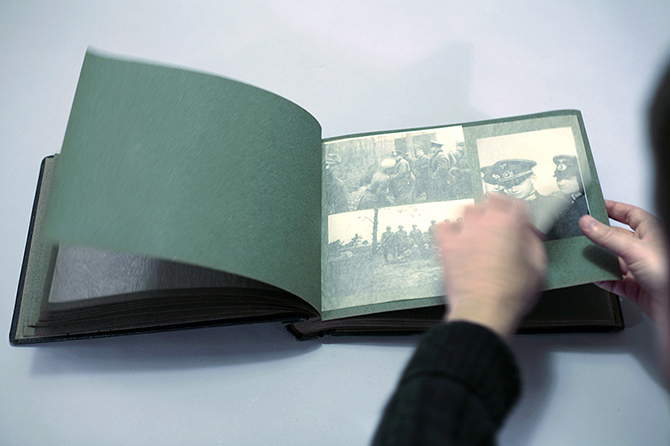
The Man Who Hid Wolfgang Gerhard / Daniel Barroca / São Paulo / 2012
April 28th 2012. Benedito Calixto market, São Paulo. I come across military objects on several of the stands. Almost all of them are European. Most from the First and Second World Wars. Many of them Nazi. Helmets, medals, photographs, post-cards, daggers, insignia, documents. There were two cases with small collections of objects, the photo of a German battle ship was displayed next to the fragment of a uniform with a name embroidered along with a diploma stating that Klaus Hoffman had been part of the crew. A little further along, a photo album with copies of pictures of a Wehrmacht soldier, a Luftwaffe medal of honor with an eagle, its wings opened over the swastika inside an iron crown of flowers, a dagger with an engraved swastika on the handle and a document written in German with a Nazi stamp atop the heading. The person manning the stand was a tall fellow with blue eyes, white hair and a little trimmed moustache, in total contrast to the European features common to Brazilian men. I asked him what the images were. He replied that they were copies of photographs belonging to his grandfather, a former Wehrmacht officer. In German he asked if I could speak German. I said I couldn’t even though I could articulate a few word combinations under very specific circumstances. Probably the question came from the fact that I hesitated before speaking Portuguese, which made him think that perhaps I spoke German. His northern European looks drove me to that conclusion. He answered in flawless Portuguese with a São Paulo accent. Disturbingly flawless, I felt, given the World War II context. The detail of his fluent use of Portuguese provoked a certain fascination in me, making me think immediately of the enormous contradiction between the xenophobic content of the material he was selling and the syncretism and miscegenation of the Brazilian society in which he was obviously integrated. And it was exactly that fact that allowed those objects, images and symbols to be shown in public without any major ideological implications. The fact that his identity was so ambiguous was also an element of fascination for me. German? Brazilian? German-Brazilian? Brazilian-German? It was also fascinating the fact that once these questions were posed trying to find an answer became so absurd. The point of fascination was the indefiniteness of that character, because potentially, in that moment, there was nothing but the impossibility of defining him. This conclusion was not a projection of the identity of that specific man but the formulation of a possible Other. A syncretic undefined Other whose acknowledgement on my part took place in my recognition of that precise indefiniteness as the essential element that made me see him as an equal. It’s in the indefiniteness that the sense of equality exists here. It’s in the indefiniteness of the Other as Other, in the acknowledgement of the Other as an Other impregnated with indefiniteness, that it makes sense to talk about alterity here. A man who is an indefinite man, as I think I am in that context. Indecipherable, untranslatable, encrypted as I think I am in that moment. This only arises from the confusion generated by his use of Portuguese in relation to his physiognomy in the context of our first contact with each other.
After asking whether I spoke German, he asked me where I came from. I said I was Portuguese and his colleague enthusiastically replied that he was too, and that he had immediately recognized my accent. He told me that the last remaining tie he had with Portugal was an 87 year old aunt who was on the verge of death. He was born in Coimbra but his father took him to São Paulo when he was 12 years old and he hadn’t lived in Portugal since. He only came back for short periods of time to visit his family. He showed me a Bordalo Pinheiro pottery piece that I had trouble recognizing because of its simplicity. At the end of our conversation he mentioned that his Portuguese accent always came back when he was in Portugal. I thought this significant because it seemed essential for understanding the layers of his identity, and I considered this phenomenon to possibly be a general representation of identity unfolding, an archetype. Identity as a superimposition of life experiences and elements not immediately connected to any one experience, held within deeper layers that are either more or less latent, more or less active. More or less hidden layers that gradually emerge or are submerged during a lifetime and are constituted by inherited traits from previous generations. Those layers constitute the individual and are unconsciously articulated through his daily experience. That articulation happens more or less intensely, more or less openly, even though it takes a great effort to identify their origins and outlines. In the course of my conversation with the German, this seemed to be a new important element towards understanding the Brazilian context of syncretism and the fusion of cultures and meanings. What fascinated me was the possibility that a detail in a person’s life, supposedly lost in the past, could emerge in the present if stimulated by favorable conditions. It lead me to think that this could also happen with elements an individual’s character and that certainly there are dormant niches within each one of us ready to erupt more or less violently. In the end, the idea that there are remains of the past asleep inside an individual in a way that can not only be recalled but also reincarnated made me think about the work I’ve been producing on the traumatic memories of war, the political memory of dictatorships, the memory held inside places of political torture, on repression, and about the way I’ve been incorporating all of that in my artistic practice, and my developing awareness of how much of that exists within me, how much of me is also made of that. The marks left by a violent gesture can re-spawn inside. Those marks somehow prevail beyond their temporary visibility. They prevail out of view, becoming manifest through unpredictable eruptions. An artistic practice can serve to channel that mysterious inner violence.
“Stories are one thing; history is another; and truth, another.” Dieter pronounces these words with a lifted finger and with his eyes fixed on me. He stops short of taking a tough stance, and ends the sentence with a slight smile that subtly turns into laughter. Nods his head to emphasise the weightiness of the subject and continues to stare at me with glazed eyes. It’s an opaque look that prevents emotions from entering or exiting, but shows self-assurance. A self-assurance that was not exactly presence of mind; it was as if that figure were animated by something in fact almost inanimate. I nodded and opened my eyes wider to indicate my curiosity. I made an effort to be the passive and naïf listener that in fact I was. The sentence had an impact on me and I didn’t want to pronounce any judgment that could put an end to the conversation. His voice had a cautious tone to it that revealed a certain fascination for the subject of the war and at the same time a certain apprehension about taking a wrong step. I said “yes” and gave him space to continue. Dieter put his right hand into the small bag he carried over his shoulder and took out a few papers. These were photographs and documents. He showed me a picture of his grandfather wearing the Wehrmacht uniform. Dark background, a bust-shot, staring into the camera with the body in profile. He stares into the camera like someone staring at the viewer, directly into the eyes with just the right artificial smile for the circumstances. It was a small pocket print. “This is my grandfather, my beloved grandfather! An incredible man!” He spoke in an exaggerated way as if in a piece of burlesque theatre. He drew out another document from the little shoulder bag, impossible for me to read since it was written in German, with a print of the same image stapled to a document. The paper seemed convincingly yellow but the little metal staple attaching the photo to the document was surprisingly new and shiny in comparison to the aged paper. I don’t know enough about that type of document to make a judgment on the print and design, they looked authentic. On the other hand, the contradiction between the ages of the paper and the metal raised some suspicion. Dieter said that this was the document that had saved his grandfather from the French shooting squad at the end of the war. It supposedly declared that this soldier was allowed to go free. This decision was owing to the fact that the first shooting attempt had failed and that therefore the convict should be released. Dieter said it was something written in the rules of war. The irony was that in the face of the shooting squad the man had achieved life and freedom instead of death. The business partner added that, sometime ago, Dieter had sold all of the old original documents to another antique salesman and that this was a copy. He said that everything that Dieter had to sell at the moment were just copies. Nothing was left. He said it in a patronizing way with a moralist’s contempt, shaking his head in a sign of reproach. Dieter was a lonely old man apparently specialized in forging and dealing in his own private family memories. The Portuguese walked away to look for something but raised his head again, stared in my direction and said: “Once I met the man who hid Mengele.”[1]
[1] Wolfgang Gerhard was the man who hid Joseph Mengele in São Paulo during the 70’s and when returned to Austria, his country of birth, gave his Brazilian documents and his house to Joseph Mengele who assumed his identity. Wolfgang Gerhard was the last name that Mengele used before he drowned in a beach in the São Paulo state in 1979. The history of Mengele in Brazil has several versions and continues uncertain and controversial.
(co-edited by Christabelle Peters)

O homem que escondeu Wolfgang Gerhard / Daniel Barroca / São Paulo / 2012
28 de Abril de 2012. Mercado Benedito Calixto em São Paulo. Encontro objectos militares em várias bancas. Quase todos europeus. A grande maioria da primeira e segunda grande guerra mundial. Muitos deles nazis. Capacetes, medalhas, fotografias, postais, punhais, insígnias, documentos. Havia duas molduras com pequenas colecções de objectos, a fotografia de um couraçado alemão aparecia ao lado do fragmento de um uniforme com o seu nome bordado juntamente com um diploma que atestava que Klaus Hoffman fazia parte da tripulação. Mais à frente um álbum fotográfico com cópias de fotografias de um soldado da Wehrmacht, uma condecoração da Luftwaffe com uma águia de asas abertas sobre a suástica dentro de uma coroa de flores em ferro, um punhal com uma suástica gravada no cabo e um documento escrito em alemão com o selo nazi no cabeçalho. A pessoa que cuidava da banca era um homem alto, de olhos azuis, cabelo todo branco e um pequeno bigode bem aparado que nada tinha a ver com o brasileiro baixo, moreno e ágil no samba dos lugares comuns europeus. Perguntei-lhe que imagens eram aquelas. Ele respondeu que eram cópias de fotografias do seu avô, um ex-oficial da Wehrmacht. Perguntou em alemão se eu falava alemão, eu disse que não apesar de ser capaz de articular algumas combinações de palavras em circunstâncias muito específicas. Possivelmente a pergunta resultou do facto de eu ter hesitado ao falar português levando-o a pensar que eu talvez falaria melhor alemão. Não sei. A sua fisionomia do norte da Europa precipitou-me nessa hesitação. Ele respondeu em português com um sotaque paulista perfeito. Perturbadoramente perfeito para mim naquele cenário de 2ª Guerra Mundial. O detalhe do seu uso fluente do português provocou algum fascínio em mim levando-me imediatamente a pensar na enorme contradição entre a carga xenófoba do material que vendia e a sociedade brasileira sincrética e miscigenada na qual estava obviamente integrado e ser esse o facto que justamente permitia aqueles objectos, imagens e símbolos serem mostrados sem grandes implicações ideológicas. Fascinou-me essa ambiguidade e o facto de naquele instante me ter parecido que é possível que um símbolo, seja ele qual for, pode perder a sua carga simbólica. Fascinou-me também o facto da sua identidade ser uma questão ambígua. Alemão? Brasileiro? Alemão Brasileiro? Brasileiro Alemão? Fascinou-me também o facto de uma vez colocada a questão ser absurdo tentar alcançar uma resposta. O interesse está na indefinição por potencialmente, naquele momento, haver a impossibilidade da definição. Esta conclusão não seria já uma projecção da identidade daquele homem mas a formulação de uma ideia sobre um possível outro. Um outro sincrético, indefinido cujo reconhecimento da minha parte se dá por eu reconhecer essa indefinição enquanto aquilo que me faz considerá-lo um igual. É na indefinição que aqui reside o sentido de igualdade. É na indefinição do outro enquanto outro, ou seja, no seu reconhecimento enquanto outro impregnado de indefinição que se torna pertinente falar de alteridade. Um homem que é um homem indefinido, como eu penso que sou. Indecifrável, intradutível, encriptado. Como eu penso que sou. Este ponto diz apenas respeito à confusão gerada pelo seu uso do português na relação com a sua fisionomia no contexto deste nosso primeiro contacto.
Depois de me perguntar se falava alemão perguntou-me de onde eu vinha. Disse que era português ao que o seu colega respondeu entusiasticamente que também era e que de imediato reconhecera o meu sotaque. Disse-me que o último laço que tem com Portugal é uma tia de 87 anos que está à beira da morte. Contou-me que nasceu em Coimbra mas que foi com o pai para São Paulo quando tinha 12 anos e que nunca mais viveu em Portugal. Voltou por curtos períodos para visitar a família. Mostrou-me uma peça de cerâmica Bordalo Pinheiro que não pude reconhecer por ser tão sóbria. No final da conversa disse que em Portugal o seu sotaque português acaba sempre por voltar. Achei importante reter esta informação por me parecer fundamental para compreender as camadas da sua identidade. Assumi este fenómeno de desdobramento como um caso representativo e abrangente, um arquétipo. A identidade como uma sobreposição de experiências de vida e de elementos não imediatamente ligados a essa experiência acomodados em camadas mais profundas que ora ficam mais ou menos latentes, mais ou menos activos. Camadas mais obscuras que vão emergindo e submergindo ao longo da vida e que são constituídas por marcas herdadas de uma geração anterior. Essas camadas são constituintes do indivíduo e articulam-se inconscientemente com a sua experiência quotidiana. Essa articulação acontece mais ou menos intensamente, mais ou menos declaradamente ainda que exija um grande esforço para identificar a sua origem e os seus contornos. Na sequência da conversa com o alemão, este pareceu-me ser um novo dado, importante para compreender este contexto brasileiro de sincretismo e fusão de culturas e significados. Fascinou-me a possibilidade de um elemento da vida de uma pessoa, supostamente perdido no passado, emergir no presente se estimulado por condições favoráveis. Isto levou-me a pensar que isso poderia também acontecer com elementos do carácter de um indivíduo e que certamente existem nichos adormecidos em cada um de nós prontos a irromper mais ou menos violentamente. A constatação de que restos do passado estão adormecidos dentro de um indivíduo de modo a que ele não só é capaz de os relembrar mas de os reencarnar levou-me a pensar no que tenho trabalhado sobre a memória traumática da guerra, a memória política das ditaduras, a memória dos lugares da tortura política, a memória da repressão, a forma como tenho incorporado isso na minha prática artística e como tenho percebido o quanto isso está em mim, o quanto eu sou também feito disso. As marcas deixadas por um gesto violento em parte semeiam esse mesmo gesto. Essas marcas de alguma forma prevalecem para além do seu aspecto visível temporário, prevalecem invisivelmente manifestando-se em erupções imprevisíveis. Uma prática artística pode servir para canalizar essa misteriosa violência interior.
“Uma coisa são as estórias, outra é a história e outra é a verdade.” Dieter diz estas palavras com o dedo ligeiramente em riste e com os olhos fixos em mim. Não chega a assumir uma postura dura e termina a frase com um ligeiro sorriso que subtilmente se transforma em riso. Acena a cabeça sublinhando o peso do assunto, continuando fixo em mim com o seu olhar algo vítreo. É um olhar opaco que não deixa passar as emoções nem se deixa penetrar mas que transmite segurança. Uma segurança que não chega a ser presença de espírito, é como se aquela figura humana fosse animada por algo na verdade quase inanimado. Aceno positivamente com a cabeça e abrindo mais os olhos declaro a minha curiosidade, esforço-me por ser o ouvinte passivo e ingénuo que no fundo de facto era. A frase teve algum impacto em mim e eu não quis avançar nenhum tipo de juízo que pudesse por termo à conversa. A sua voz trazia um tom cauteloso que revelava um certo fascínio pelo assunto do passado da guerra e ao mesmo tempo um certo receio em dar o passo errado. Digo que sim e deixo o espaço aberto para ele continuar. Dieter leva a mão à pequena sacola que traz ao ombro e retira alguns papeis. Fotografias e documentos. Mostra-me uma fotografia do seu avô no uniforme da Wehrmacht. Fundo negro, enquadrado ligeiramente abaixo dos ombros olhando a câmara de frente com o corpo de perfil. Olha a câmara como quem fixa o observador directamente nos olhos com o sorriso artificial próprio da circunstância. Era uma pequena impressão de bolso. “Este é o meu avô, avô querido! Um homem incrível.” Diz de uma forma algo exagerada como num teatro de revista. Retira um outro documento da pequena sacola, ilegível para mim por estar escrito em alemão, no qual está uma reprodução da mesma imagem agrafada a um documento. O papel parece convincentemente amarelado mas o pequeno grampo de metal que mantém a foto agarrada ao papel está surpreendentemente novo e brilhante em comparação com o papel envelhecido. Não conheço aquele tipo de documento para fazer um juízo em relação à impressão e ao desenho, que parecem autênticos, por outro lado a contradição entre a idade do papel e do metal suscita alguma suspeita. Dieter diz ser aquele o documento que salvou o seu avô do pelotão de fuzilamento francês no fim da guerra. Supostamente aquele documento atesta que aquele soldado deve seguir em liberdade. Esta decisão deve-se ao facto da primeira tentativa de fuzilamento ter falhado e nesse caso o condenado ser libertado. Dieter disse ser uma questão prevista nas leis da guerra. Por ironia do destino, perante aquele pelotão de fuzilamento, é a vida que é alcançada e não a morte. O seu colega diz que, há algum tempo atrás, Dieter vendeu todos esses velhos documentos a um outro negociante de antiguidades que não ele e declara que aquele é uma cópia. Acrescenta ainda que tudo o que Dieter tem para vender neste momento são apenas cópias. Nada restou. Di-lo de forma paternalista, com algum desprezo moralista ao mesmo tempo que abana ligeiramente a cabeça em sinal de reprovação. Dieter é um velho solitário aparentemente especializado em falsificar e traficar a sua própria memória intima. O português afasta-se um pouco, procurando algo, mas acaba por levantar de novo a cabeça olhando na minha direcção e diz: “eu cheguei a conhecer o homem que escondeu o Mengele.” [1]
[1] Wolfgang Gerhard foi o homem que escondeu Joseph Mengele em São Paulo durante os anos 70 e que ao regressar à Austria, o seu país de origem, ofereceu os seus documentos brasileiros e a sua casa a Joseph Mengele que assumiu assim a sua identidade. Wolfgang Gerhard foi o último nome que Mengele utilizou antes de morrer afogado numa praia paulista em 1979. A história de Mengele no Brasil tem várias versões distintas e continua envolta em incerteza e controvérsia. Há quem afirme que ainda está vivo.
